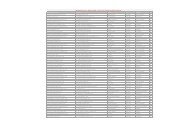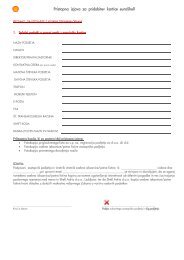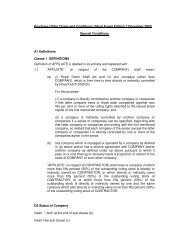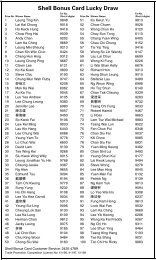OBEN GAS DEVELOPMENT PROJECT
OBEN GAS DEVELOPMENT PROJECT
OBEN GAS DEVELOPMENT PROJECT
Create successful ePaper yourself
Turn your PDF publications into a flip-book with our unique Google optimized e-Paper software.
Chapter Three Description of Environment<br />
3.2.5.5 Plant Pathological Assessment<br />
A survey of the health status of wild plant species and economic crops in the project area revealed the<br />
presence of fungal, bacterial and viral infections on the foliage of both categories of plants.<br />
The prevalent pathological conditions are leaf spot and chlorosis, which were found in over 50% of the<br />
specimens examined. Other diseases include necrosis, leaf mosaic, wet rot, and powdery mildew. The<br />
causal organisms include Aspergillus spp., Fusarium spp., Penicillium sp. and Ganoderma<br />
pseudoferreum among others. The severity index shown in Table 3.8 is based on the extent of spread<br />
of the infection within a plant and among 5 – 10 plants in a population. When more than half of the<br />
leaves on a single plant are infected, it is considered high; when more than five leaves in a group of 3 –<br />
44 plants of the population are infected, it is considered moderate, while if only 1 or 2 leaves of plants<br />
are infected it is considered a light infection.<br />
Table 3.8: Plant Diseases, Causal Organisms and Severity Index of Infection in the Project Area<br />
Nos. Plant Species Type of Disease Casual Severity % Freq.<br />
Organism Index<br />
1 Manihot esculenta Leaf mosaic ,Chlorosis Mosaic virus 2 30<br />
2 Tefiria occidentalis Powdery mildew, leaf spot Oidium levea 3 60<br />
3 Emilia coccinea Leaf spot Penicillium sp 1 20<br />
4 Alcornea cordifolia Leaf spot Fusarium<br />
moniliforme<br />
2 30<br />
5 Paspalum laxaum Necrosis, Leaf spot Aspergillus spp 1 20<br />
6 Musa sapientum Chlorosis Cigar end Pseudomonas<br />
andropogonii<br />
Trachshaea<br />
fructigena<br />
1 20<br />
7 Spigelia anthelmia Leaf spot, Chlorosis Penicillium sp.<br />
Pseudomonas<br />
fructigena<br />
3 40<br />
8 Panicum maximum Necrosis, Leaf spot Aspergillus niger<br />
Penicillium sp.<br />
1 30<br />
9 Urena lobata Leaf spot Fusarium<br />
oxysporium<br />
2 10<br />
Key to Severity Index: 0 = No infection, 1 = Light infections, 2 = Moderate infection 3 = Severe infection<br />
3.2.6 Wild Life / Biodiversity Studies:<br />
The Oben Field is located within Urhonigbe Forest reserve. This is however with approval from<br />
appropriate government agencies. Moreover, virtually much of the forest reserve has been destroyed by<br />
various kinds of human activities. Although no known data on wildlife exists for the Urhonigbe Forest<br />
Reserve, some species of fauna including (insects, molluscs, amphibians, reptiles, birds and mammals)<br />
were recorded during the current study (Table 3.9).<br />
The invertebrate fauna were diverse and consisted of forest dwelling species dominated by ants,<br />
beetles and millipedes. Many genera and species of arthropods (Ants, flies, butterflies and<br />
grasshoppers) were recorded. Some species of bugs, dragon flies and damselflies were also recorded.<br />
The Mollusca fauna was represented by the presence of the giant African land snail (Archachatina<br />
marginata suturalis) and the garden snail, Limicolaria aurora.<br />
Most of the mammals are crepuscular, feeding in the early hours of the day or just before dusk.<br />
Rodents and pottos dominated the mammalian class. Forest dwelling species, seed and insect-eating<br />
3-13

















